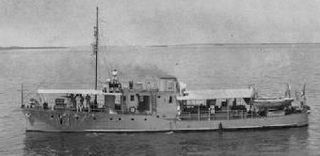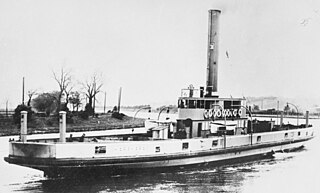
HMAS Benalla (J323/M323), named for the city of Benalla, Victoria, was one of 60 Bathurst-class corvettes constructed during World War II, and one of 36 initially manned and commissioned solely by the Royal Australian Navy (RAN). Built by HMA Naval Dockyard in Victoria, Benalla was fitted out as armed survey ship instead of a minesweeper like the rest of the class, and was commissioned into the RAN in 1943.

HMAS Deloraine (J232/M232), named for the town of Deloraine, Tasmania, was one of 60 Bathurst-class corvettes constructed during World War II, and one of 36 initially manned and commissioned solely by the Royal Australian Navy (RAN). In January 1942 she evaded an attack by the Japanese submarine I-124 north-west of Darwin and was jointly credited with the submarine's sinking after inflicting the initial damage. She was present at the bombing of Darwin and survived unscathed.

HMAS Goulburn (J167/B243/A117), named for the city of Goulburn, New South Wales, was one of 60 Bathurst-class corvettes constructed during World War II, and one of 20 ordered by the British Admiralty but subsequently manned and commissioned solely by the Royal Australian Navy (RAN).

HMAS Inverell, named for the town of Inverell, New South Wales, was one of 60 Bathurst-class corvettes constructed during World War II, and one of 36 initially manned and commissioned solely by the Royal Australian Navy (RAN).

HMAS Latrobe (J234/M234), named for the town of Latrobe, Tasmania, was one of 60 Bathurst-class corvettes constructed during World War II, and one of 36 initially manned and commissioned solely by the Royal Australian Navy (RAN).

HMAS Platypus was a submarine depot ship and base ship operated by the Royal Australian Navy (RAN) between 1919 and 1946. Ordered prior to World War I to support the Australian submarines AE1 and AE2, Platypus was not completed until after both submarines had been lost, and she was commissioned into the Royal Navy from 1917 to 1919.

HMAS Westralia (F95/C61) was an auxiliary cruiser of the Royal Australian Navy (RAN). Built by Scottish shipbuilder Harland and Wolff and completed in 1929, Westralia was operated by the Huddart Parker company until 1939, when she was requisitioned for service with the RAN as an Armed Merchant Cruiser (AMC). Fitted with guns and commissioned in early 1940, Westralia was initially used to escort convoys in the Pacific and Indian oceans. In November 1940, the largest mutiny in RAN history occurred aboard the ship, with 104 men charged.

HMAS Patricia Cam was an auxiliary vessel operated by the Royal Australian Navy during World War II. She was sunk by a Japanese aircraft in 1943.

HMAS Bungaree was an auxiliary minelayer of Royal Australian Navy (RAN), serving during World War II. The ship was built as a cargo vessel for the Adelaide Steamship Company by Caledon Shipbuilding & Engineering Company at Dundee, and launched in 1937. The ship operated in Australian waters and was requisitioned by the RAN in October 1940. Decommissioned on 7 August 1946 and returned to her owners on 5 November 1947, she was sold in 1957 and renamed Dampier. She was then sold in 1960 and renamed Eastern Mariner and while operating in South Vietnamese waters she struck a mine on the Saigon River and was sunk on 26 May 1966. She was salvaged by a Japanese company and subsequently scrapped in 1968.

HMAS Vigilant was an auxiliary patrol boat serving with the Royal Australian Navy during the Second World War. Notably it was the 120th ship built by the Cockatoo Island Dockyard and the first aluminium ship built in Australia.

HMAS Doomba was a Royal Australian Navy (RAN) warship of World War II. Built for the Royal Navy around the end of World War I as the Hunt-class minesweeper HMS Wexford, the ship only saw two years of service before she was decommissioned in 1921 and sold to the Doomba Shipping Company. The vessel was renamed SS Doomba, converted into a passenger ship, and operated in the waters around Brisbane until 1939, when she was requisitioned by the RAN for wartime service. Serving first as an auxiliary minehunter, then an auxiliary anti-submarine vessel, HMAS Doomba was purchased outright by the RAN in 1940, and served until early 1946, when she was sold and converted into a linseed oil lighter. Doomba was scuttled off Dee Why, New South Wales in 1976.

MV Duntroon was a passenger motor ship built for the Melbourne Steamship Company, that saw military service as a troopship between 1942 and 1949. She was built by Swan, Hunter & Wigham Richardson, Walker, Newcastle upon Tyne, and entered service in 1939.

HMAS Terka (FY.98) was an auxiliary minesweeper operated by the Royal Australian Navy (RAN) during World War II. The ship was launched as Sir Dudley de Chair in 1925 as one of the three ships used to supply the construction of the Sydney Harbour Bridge, and from 1928 operated by the Adelaide Steamship Company until she was requisitioned by the RAN in December 1940. She sank while at her moorings at Madang, New Guinea on 26 March 1945 and was abandoned.
HMAS Medea was an auxiliary minesweeper of the Royal Australian Navy (RAN) between 1942 until 1946. Built in 1912 for the Ocean Steam Ship Co. she was sold to the Straits Steam Ship Co. in 1925. She was requisitioned by the Royal Navy in 1939 and converted into an auxiliary minesweeper and named HMS Circe. She was transferred to the Royal Australian Navy in 1942 and renamed HMAS Medea until she was returned to her owners in 1946. She was sold and was scuttled off Sydney on 20 January 1948.

Yandra was a 990-ton coastal steamer built by Burmeister & Wain, Copenhagen in 1928 for Coast Steamships for service in the Australian state of South Australia. She was requisitioned by the Royal Australian Navy in June 1940 during World War II for conversion to a minesweeper and anti-submarine vessel and was commissioned on 22 September 1940 as HMAS Yandra. She returned to civilian service in 1946. She ran aground during dense fog onto South Neptune Island on 25 January 1959 and was subsequently written off.

HMAS Kara Kara was a Royal Australian Navy boom gate vessel, converted from a Sydney Ferries Limited ferry.

HMAS Wilcannia was a 1,049-ton anti-submarine and patrol vessel of the Royal Australian Navy (RAN).
HMAS Orara was a coastal passenger and cargo steamship that was built in Scotland in 1907 and sunk by a mine in China in 1950. She spent most of her career in the fleet of the North Coast Steam Navigation Company (NCSNC) of New South Wales. In the Second World War she was an auxiliary minesweeper and depot ship in the Royal Australian Navy.
HMAS Toorie was an auxiliary minesweeper operated by the Royal Australian Navy (RAN) during World War II.

HMAS Gunbar (GN) was an auxiliary minesweeper operated by the Royal Australian Navy (RAN) during World War II.
















